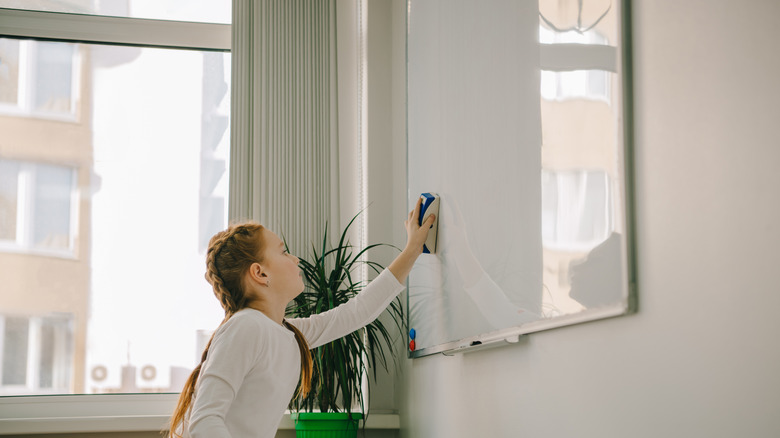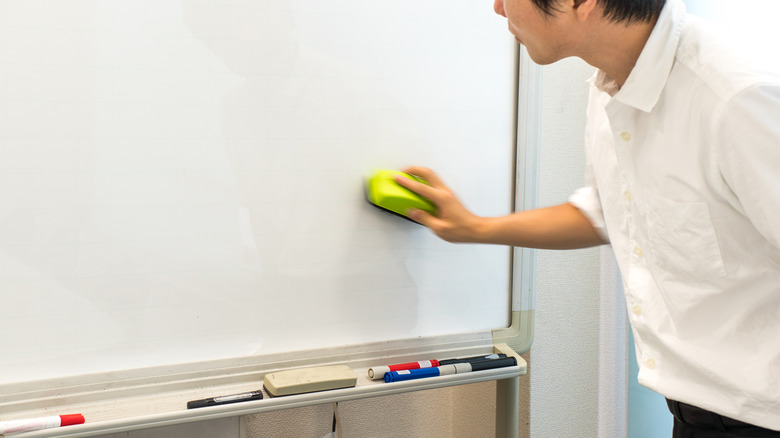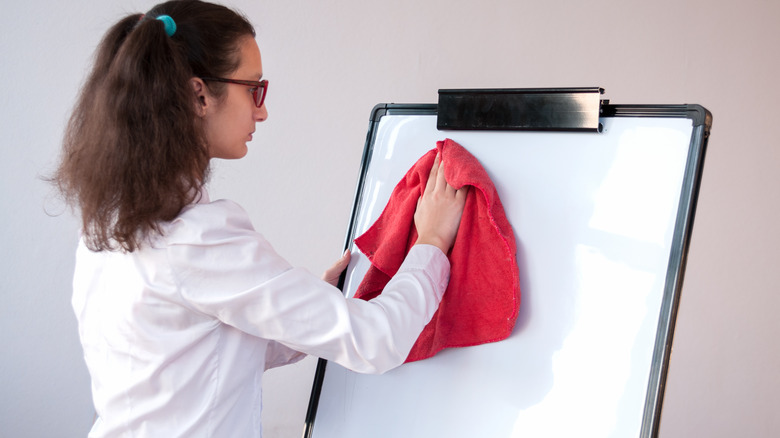The Best Way To Clean A Whiteboard
Although common in classes and offices, whiteboards are a useful tool even in homes. They provide a surface for jotting down your daily task, especially if you prefer the conventional hands-on approach, as opposed to typing. The beauty of this writing surface is that they are available in different sizes, ranging from small hand-held options to extra-large ones that will easily cover an entire wall. However, if you have used a whiteboard, you will be aware of its tendency to stain after some time.
According to Clarus, the main reason for the unsightly marks on your whiteboard is that the dry-erase ink is made of some of the same color elements as permanent markers. Moreover, once the stains start showing, you will need to clean the board more frequently because they tend to add up quickly. So, what is the best approach to cleaning your whiteboard? Fortunately, there are easy ways of ridding your board of ugly marks. Here is a quick and easy guide to help you bring your whiteboard back to its former glory.
What is your whiteboard made of?
Before you can begin cleaning your whiteboard, it is important to identify the material your whiteboard is made of. Displays2go notes that there are three popular materials for making whiteboards — melamine, porcelain, and glass. Since these materials are all different they require different methods of cleaning. Glass is unlikely to stain, however, melamine whiteboards are porous in nature, and will need more care and attention.
Although you can use the same products to clean all three materials, you ought to be careful of the type of chemical cleaners you use on melamine. Abrasive cleaners will often do more damage than good on the porous melamine surface. What's more, Displays2go further mentions that this material is prone to staining more than the others, and is better for light use and for markings that are not left to stay on the board for a long time.
Use the marker to erase the stains
Whether the whiteboard is stained from extended use or you accidentally used a permanent marker on the board, removing these stubborn marks is easier than you would imagine. One simple technique to do is to draw or color over the marks with a dry-erase marker. Although this might appear counter-intuitive, it is the first step to removing the stains.
Clarus explains that dry-erase ink is made of a chemical solvent, a color pigment, and a polymer. As such, when you draw over the stain from the permanent marker, the solvent in the dry-erase ink helps dissolve it, making it easy to erase with your regular wipe, per SGS Polymer Solutions Incorporated. However, before wiping down, be sure to allow the dry-erase ink to dry completely making the ink underneath lift off easily. A regular whiteboard dry-eraser should be enough to clean the surface, however, if the first try doesn't take away all the markings, you can always give it another go.
Wipe the surface with a cleaning solution
While there are several different products dedicated to cleaning a whiteboard, it is worth mentioning that some general household items like vinegar and rubbing alcohol are equally cut out for the job. To effectively clean the writing surface with these products, be sure to dampen a clean microfiber cloth with the solution and carefully clean the whiteboard until it is white and bright.
The Western States Pediatric Environmental Health Specialty Unit mentions that microfiber cloths are absorbent and quite gentle on surfaces, making them perfect for your board. It is recommended to start wiping from the top so as to catch any unnecessary drips. Immediately after, rinse off the product from the cloth with water, and wipe the whiteboard again to eliminate the remnants of the cleaning solution from the surface. Allow the whiteboard to fully air dry before putting it to use again.
Preventing your whiteboard from staining
Although you cannot fully prevent stains on your whiteboard, you can reduce how frequently they occur. One way of doing this is wiping it clean as soon as you no longer need what is written on it. This is particularly true for melamine whiteboards that are porous and prone to leaving marks. Doing this will prevent the ink from the marker from seeping into the surface. Also, The WebstaurantStore recommends cleaning the whiteboard with a cleaner of your choice at least twice every week to keep it in tip-top shape.
Another point worth putting across is that you need to limit the use of rubbing alcohol on your whiteboard. Although rubbing alcohol works like magic, continuous exposure to these chemical compounds may destroy the writing surface, per Magnatag. Reserve rubbing alcohol for a few isolated extreme cases for the sake of retaining the integrity of the writing surface.




